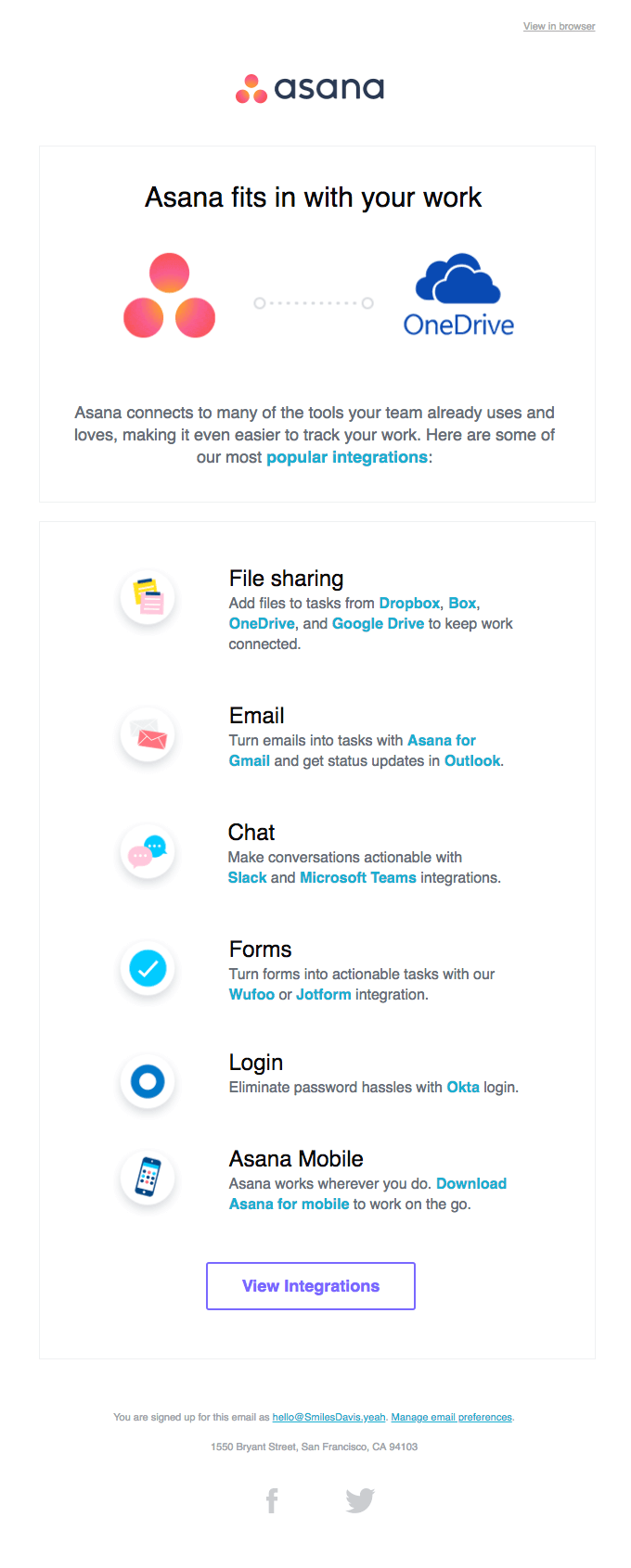12 ways to write better B2B email marketing copy
Allow us to let you in on a little secret: business-to-business is one of the best places to be in the marketing space.
No offense to our business-to-consumer friends, but some things are just a little easier when you understand the real business needs of the people you’re marketing to. At their core, all businesses face similar roadblocks to productivity, scalability, and growth—and they are all looking for new, innovative ways to help their company succeed. As a B2B marketer yourself, you are in a prime position to speak to those needs.
That's why 68% of B2B marketers say email is their most effective digital channel for marketing. And this is exactly why B2B email marketing is so interesting and fun (or at least, it should be, once you get the hang of it) because you’re not just sending emails into a meaningless void; you’re sending them to people looking for a solution to their problem.
How to write better B2B email marketing copy: The basics
We’ll bet that you’re already great at talking to other businesses face-to-face, know exactly how you can help them and vice versa. To translate that into email marketing copy that converts, you need to keep those same B2B concepts in mind:
- The problems they care about as a business owner.
- The ways your business can solve those issues.
- How you can help each other achieve your goals.
These relationship points are the best places to start when writing B2B copy that converts. If you forget the basis of your relationship with another business, it won’t matter what else your message says—you’ll already have lost your reader.
But if you’re confident in these concepts and excited to share your ideas with them, you’re ready to move on to the nitty-gritty of writing better B2B email copy. Let’s walk through a few do’s and don’ts to bring your emails to the next level:
1. Don’t: Write to sell.
Yes, your end goal probably is to sell something. However, when you’re writing copy, that’s not how you want to come across. Especially when you’re writing to other businesses, your subscribers will be able to see straight through your sales tactics.
Avoid sales words that sound spammy, like “Great deal,” “big discount,” or “product is going fast—get yours NOW!” Additionally, use caps-lock sparingly. You don’t want your readers to feel like you’re yelling at them!
2. Do: Write to gain trust.
This is important in all copywriting, but when you’re writing for B2B, it’s a chance to really show empathy and understanding. And, just as we mentioned before, you do have a real advantage here. You’re always more likely to trust someone who has been in the same situations and can speak from experience and the same applies here.
Businesses that have put in the hard work to provide solutions to their customers are going to notice the ways you’ve done the same for them. When you write copy from a place of seeking trust instead of purchase, you allow this expertise to show. (And, increased trust=more purchases. Win-win.)
3. Don’t: Focus on yourself.
It’s true that your business has a lot to offer. When you have a product and services you truly believe in, it’s natural to want to turn everyone you meet into a customer. But at the same time, no one likes the party guest who only knows how to talk about themselves.
You want to be the kind of business who doesn’t just offer great solutions but is also focused on how their solutions make a customer feel. Which brings us to our next point...
4. Do: Focus on the reader.
Since you know your reader’s name (make sure you ask for it when they sign up!), use it as a way to show you care about them as an individual as well as a business.
In case you need a little more proof, Campaign Monitor found that personalization increases open rates by 26%. When you write from the perspective of acknowledging and understanding your reader’s needs, they’re much more likely to listen.
Asana does a great job of acknowledging potential business needs:
5. Don’t: Tell irrelevant stories.
You’ve probably heard that storytelling is one of the best marketing tricks of the trade, and it is. Stories empower people and inspire them to take action. At least, good stories do. If your story is long or doesn’t connect with your reader, it can actually hurt more than help.
In email marketing, fewer words are better. Don’t write a novel-length message and expect your reader to savor every word during their lunch break. As a company, stories aren’t just “he said, then she said.” Everything you do tells a story, so be intentional about your actions.
6. Do: Tell intentional stories.
Why do you do what you do? What inspires you to come to work in the morning? These are the stories you should be telling. They don’t all have to include a play-by-play, but every message you send should give a sense of who you are and where you’re headed.
There are a lot of great B2C companies out there telling intentional stories that we can still learn from in B2B, like Jeni’s:
7. Don’t: Let the subject line and preheader copy text be an afterthought.
While we’re on the subject of storytelling, the subject line and preheader text are like the book cover and introduction to your story. They’re what tell the reader if your message is something they’d be interested in or not, so make sure they’re supporting the rest of your email message.
8. Do: Be clear and concise.
There is a time and a place for SAT words and poetic verses, but email marketing is not it.
The ideal email length is shorter than you may think—about 50 to 125 words, or about the size of this paragraph. Because your message isn’t the only one in a reader’s inbox, you want to make sure to capture their attention right away and maintain it with clarity and a message that gets to the point right away.
We can learn from the organization of RealTime Board’s email:
9. Don’t: Embarrass your high school grammar teacher.
Bad grammar or spelling could, unfortunately, be the one thing standing between you and a customer who converts. Typos and lack of proofreading communicate that you don’t have time to carefully craft a message for your readers and are focused on things you deem to be more important.
Use spell check, always proofread your emails before sending them and ask a second set of eyes to look out for things you may not catch as easily. The extra time spent on editing your email is way better than the long-term embarrassment of using the wrong form of “their,” “there,” or “they’re.”
10. Do: Have a clear call-to-action.
You know more than anyone that businesses are pulled in a million different directions by the second and their time to read email is limited. This is why you should write the kind of email you’d imagine yourself reading—interesting and personable, but clear and purposeful.
Your call-to-action should be the focal point of the email, and your reader should never question why you sent it. There’s actually a lot of psychology behind a great CTA, and below we’ve provided some examples that drive clicks:
- “Reserve your seat.”
- “Count me in!”
- “Sign up and save.”
- “Let us know how we did.”
- “Book your next appointment.”
11. Don’t: Forget your company’s value.
Remember: you aren’t just sending an email, you’re providing valuable solutions to your B2B readers. Emails can get a bad reputation for causing “noise,” but when the offered value is obvious, your message won’t belong in that category.
When you’re writing copy, approach it like you would a business proposition or collaboration—lead with the customer value of your product or service, and let the rest of your message support this idea.
12. Do: Remember who your audience is.
There’s a reason we began and ended with this idea: Know your audience. Picture who you’re talking to as you craft copy, and it will naturally sound a lot more conversational and approachable.
Where is your reader when they receive your email? What challenges are they facing at that moment, and how can you help them? In what ways can you create brand loyalty by meeting them where they are when they need it most?
Don’t forget who is reading your words on the other side of the screen. That’s the real secret: business-to-business is actually just person-to-person.
Wrap up
Writing better B2B email marketing copy doesn’t have to be a chore. In fact, it’s likely to become one of your best relationship-building tools that helps you create and maintain significant connections with other businesses. Grammar is important and personalization is everything, but neither will be successful without the expression of understanding and the intention to build a relationship. When businesses see that you’re on their team, they’ll want to link arms with you, too.
MOST RECENT ARTICLES
Want to engage your audience and grow your brand? Try Emma's robust easy-to-use product today.
















